Introduction
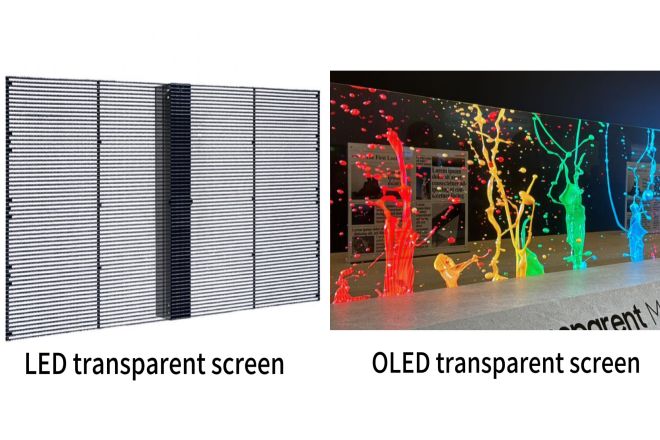
With the continuous development of science and technology, transparent display technology has gradually become a highlight in the field of modern display. With its unique transparency and high-definition display effect, transparent display screens have brought a new visual experience to many fields, such as commercial display, public transportation, smart home, etc.
Among the many transparent display technologies, Écrans transparents LED and OLED transparent screens have attracted much attention in the market with their respective advantages.
1. Introduction to LED transparent screen
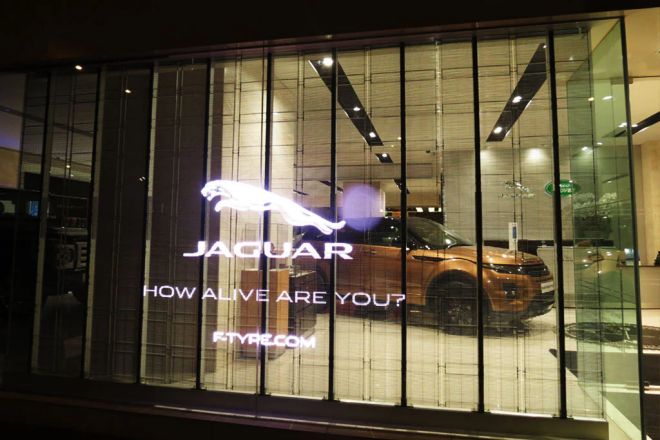
LED transparent screen, also known as transparent LED display, is a major innovation in modern display technology. The core of this display lies in its unique structure. It uses a large number of micro LED lamp beads as display units and cleverly installs these lamp beads on a transparent substrate. These substrates are usually made of glass or high-strength plastic, which ensures the overall transparency of the screen and the stability of the structure.
In the non-luminous state, the transparent substrate of the LED screen allows light to penetrate freely, making the scene behind the screen clearly visible without any obstruction. This feature makes the LED transparent screen have extremely high application value in scenes such as commercial display, window decoration, and architectural glass curtain walls because it can provide rich visual information without interfering with the line of sight.
When the LED transparent screen is turned on, tens of thousands of micro LED lamp beads will light up according to the preset pattern or video content, forming a clear and bright display effect. These LED lamp beads have excellent brightness and color expression and can present bright and vivid images to attract people’s attention.
The characteristics of LED transparent screen mainly include:
Haute transparence : When the image is not displayed, the screen is almost completely transparent and can be well integrated with the surrounding environment.
Haute luminosité et couleurs vives : LED lamp beads can emit high-brightness light, and the colors are bright and full, and the display effect is outstanding.
Forte plasticité : LED transparent screens can be made into various shapes and sizes to meet different display needs.
Économie d'énergie et protection de l'environnement : LED has high luminous efficiency, low energy consumption, and low heat generation, which is conducive to energy saving and environmental protection.
Longue vie: LED lamp beads have a long life, high reliability, and low maintenance cost.
2. Introduction to OLED transparent screen
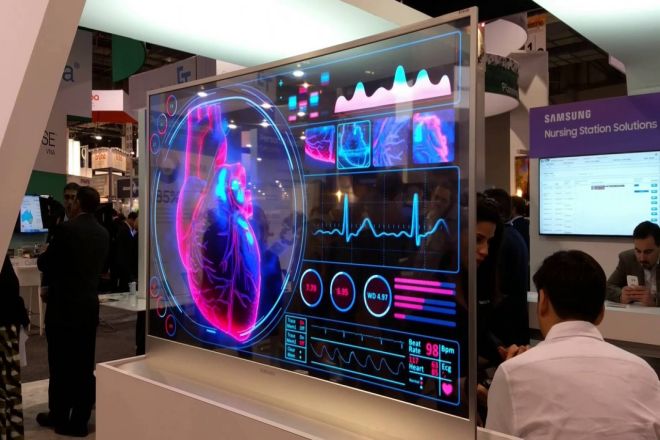
OLED transparent screen, the name may sound a bit complicated, but in fact the principle behind it is relatively intuitive and easy to understand. First of all, we need to understand OLED, that is, organic light-emitting diode (Organic Light-Emitting Diode). This is an advanced display technology, and its core lies in the characteristic of “self-luminescence”.
Imagine that traditional LCD TVs or computer monitors need a backlight to illuminate the pixels on the screen, but OLED is different. Each of its pixels has the ability to self-luminesce.
This means that when we want to display an image or text on the screen, we only need to activate the corresponding pixels, and they will emit light by themselves without the need for additional light sources.
Now, when we combine OLED technology with transparent display screens, we get OLED transparent screens. The special thing about this screen is that its substrate is transparent, and the OLED pixels are evenly distributed on this transparent substrate. Therefore, when the OLED pixels are not emitting light, the entire screen appears transparent, and we can clearly see the scene behind the screen.
The main features of OLED transparent screens include:
Self-luminescence: OLED pixels can emit light independently without a backlight, making the screen thinner and more transparent.
High contrast and viewing angle: The contrast of OLED transparent screens is extremely high, which can present deeper blacks and brighter colors. At the same time, because the OLED light-emitting layer is flat and the light is evenly distributed, the screen has a wider viewing angle.
Fast response: The response time of an OLED transparent screen is extremely short, and it can respond to image changes quickly to avoid smearing.
High color saturation: The color saturation of an OLED transparent screen is as high as 98%, which can present more realistic and vivid images.
Flexible et pliable : OLED materials are flexible and can be made into bendable and foldable displays, providing more possibilities for future display technology.
3. Performance parameter comparison
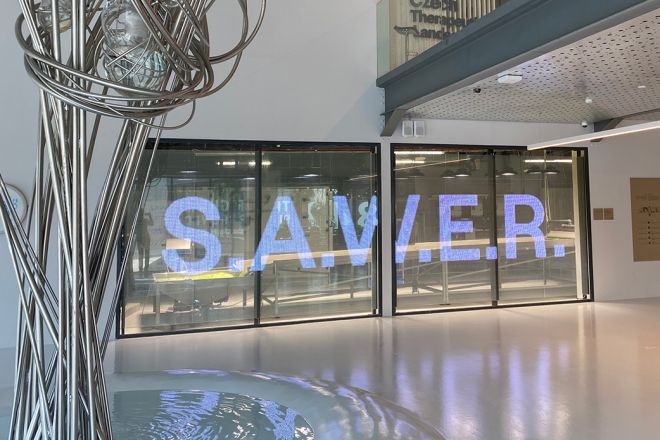
1). Brightness and contrast
- Écran transparent LED :
The LED transparent screen usually has a high brightness performance, and the basic brightness can reach 4000-5000cd/㎡. This is because the LED lamp beads are directly exposed to the outside without any obstruction, so the brightness is higher.
However, at high brightness, the contrast of an LED transparent screen may be affected to a certain extent because the high-brightness background may reduce the contrast between the image and the background.
- OLED transparent screen:
The brightness of an OLED transparent screen is generally between 1000-1500 nits, which is slightly lower than that of an LED transparent screen. However, due to its self-luminous characteristics, the contrast of an OLED transparent screen is extremely high and theoretically can reach infinity.
This makes the image appear black and white and more vivid in color when it is presented on the OLED transparent screen.
2). Viewing angle and color
- Écran transparent LED :
The viewing angle of the LED transparent screen is generally around 140° horizontally and 140° vertically. Within this range, the color performance is relatively stable. However, when the viewing angle deviates from this range, the color may be distorted.
- OLED transparent screen:
The viewing angle of the OLED transparent screen is wider because the OLED light-emitting layer is flat, and the light is evenly distributed, so the color performance remains consistent at almost any angle. In addition, the OLED transparent screen has a significant advantage in color saturation and can present more vivid and realistic images.
3). Response time
- Écran transparent LED :
The response time of the LED transparent screen is usually below 3ms, which means that when displaying dynamic images, the LED transparent screen can respond to image changes faster and avoid smearing.
- OLED transparent screen:
The response time of the OLED transparent screen is even better, usually below 1 ms. This allows the OLED transparent screen to provide smoother and more coherent visual effects when displaying high-speed dynamic images.
4). Power consumption and lifespan
- Écran transparent LED :
The power consumption of the LED transparent screen is relatively low, thanks to the efficient light-emitting characteristics of the LED lamp beads. However, the specific power consumption level depends on factors such as screen brightness and size. In terms of lifespan, LED transparent screens usually have a longer lifespan and can run stably for tens of thousands of hours.
- OLED transparent screen:
The power consumption of OLED transparent screens is also relatively low, but due to its self-luminous characteristics, each pixel needs to be powered independently, so the overall power consumption may be slightly higher than that of LED transparent screens of the same size.
However, the lifespan of OLED transparent screens is also very long, and they can run stably for more than tens of thousands of hours. In terms of energy saving and long-term operating costs, both have good performance.
4. Application scenario comparison
1). Affichage commercial
1.1). LED transparent screen:
Publicité commerciale : LED transparent screens have significant advantages in the field of commercial advertising due to their high brightness, high contrast, and clear and realistic display effects. It can attract customers’ attention and increase the click-through rate and conversion rate of advertisements.
Window display: The transparency of LED screens allows merchants to play advertisements or product information on the screen without affecting the display of goods in the window, further attracting customers’ attention.
1.2). OLED transparent screen:
- High-end commercial display: OLED transparent screens have a unique value in high-end commercial displays with their high transparency, high contrast, and bright color expression. It can create a unique visual experience for brands and products, and enhance brand image and recognition.
2). Public Transportation
2.1). LED Transparent Screen:
- Subway, Bus: LED transparent screens are widely used in public transportation such as subways and buses. For example, in subway cars and bus platforms, LED transparent screens can display vehicle arrival information, advertisements, and other content in real time, providing convenient information services for passengers.
2.2). OLED Transparent Screen:
In-vehicle Display System:
OLED transparent screens have potential applications in in-vehicle display systems. For example, it can be used as part of the window to provide navigation, entertainment, and other information without affecting passengers’ viewing of the scenery outside the car.
In addition, OLED transparent screens can also be used in subway windows to display basic information such as subway operation route maps and surrounding business districts in real time.
3). Smart Home and Building
3.1). LED Transparent Screen:
Smart Home: LED transparent screens can be used on smart home devices such as refrigerators, mirrors, etc. It can display information such as weather, time, and home safety, improving the convenience and intelligence of home life.
Smart Building: LED transparent screens can be used in public areas of smart buildings, such as lobbies, corridors, etc. It can be used as a medium for information release to display guide information, event notifications, etc., inside the building.
3.2). OLED transparent screen:
- Future science and technology buildings:
OLED transparent screen plays a key role in creating future science and technology buildings. It can be used as part of the building facade to add more artistic atmosphere and fashion sense to the city by displaying dynamic artworks or advertisements.
In addition, OLED transparent screens can also be used in the interior space of the building, such as transparent partitions, stair handrails, and other locations, to achieve the effect of displaying information and separating spaces.
5. Cost and market prospects
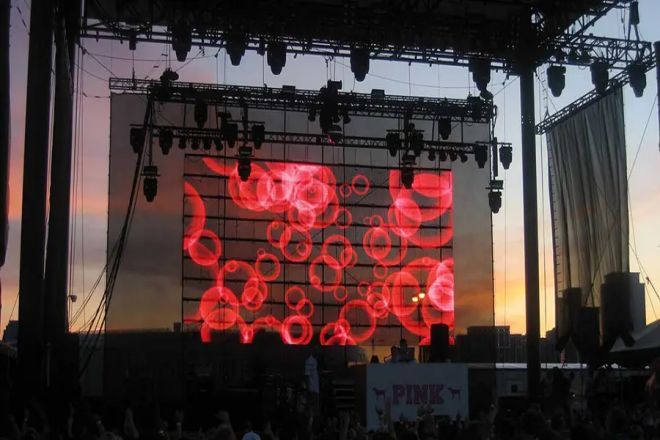
1). Cost analysis
1.1). Manufacturing cost
- Écran transparent LED :
The manufacturing cost of LED transparent screens is relatively low, mainly due to the mature production process of LED lamp beads and low material cost. In addition, the substrate of LED transparent screens usually uses low-cost materials such as glass or plastic, which further reduces the manufacturing cost.
However, in high-end application scenarios, such as large-scale commercial displays and high-end architectural applications, the cost of an LED transparent screen may rise significantly due to the need for higher resolution, brightness, and customization.
- OLED transparent screen:
The manufacturing cost of an OLED transparent screen is relatively high, which is mainly due to the high cost of OLED materials and the complexity of the production process. The OLED transparent screen requires special substrate materials and packaging technology to ensure its transparency and stability.
In addition, the pixel density and resolution of OLED transparent screens are usually higher, which also increases the manufacturing cost. However, with the continuous advancement of technology and the emergence of economies of scale, the manufacturing cost of OLED transparent screens is expected to gradually decrease.
1.2). Cost-effectiveness
In low- and mid-end application scenarios, such as public transportation billboards, small commercial displays, etc., LED transparent screens usually have better cost-effectiveness due to their lower manufacturing costs and higher cost-performance ratio.
In high-end application scenarios, such as high-end commercial displays, science and technology exhibitions, etc., OLED transparent screens can provide a higher level of visual experience due to their unique display effects and design advantages, so they have better cost-effectiveness.
1.3). Cost change trend
With the advancement of technology and the intensification of market competition, the manufacturing costs of both LED transparent screens and OLED transparent screens are expected to gradually decrease. However, due to the particularity of OLED transparent screens in technology and materials, the extent of their cost reduction may be relatively small.
2). Market prospects
2.1). Market size and growth trend
The current transparent display market is in a rapid growth stage, mainly due to the growing demand of consumers for high-quality visual experience and the continuous expansion of transparent display applications in various fields.
It is expected that in the next few years, the transparent display market will continue to maintain a high-speed growth trend and the market size will further expand.
2.2). Competition pattern and development trend
- Écran transparent LED :
Due to its lower cost and higher cost performance, the The LED transparent screen has a greater competitive advantage in the low-end and mid-end markets. In the future, LED transparent screens will continue to maintain their leading position in public transportation, commercial display, and other fields and may further expand to smart homes and architecture and other fields.
- OLED transparent screen:
OLED transparent screen has a unique competitive advantage in the high-end market, and its unique display effect and design advantages can meet consumers’ demand for a high-quality visual experience.
In the future, OLED transparent screens will continue to maintain their leading position in high-end commercial display, science and technology exhibitions, and other fields, and they may further expand to in-vehicle displays, smart homes, and other fields.
- Concurrence sur le marché :
With the expansion of the market and the intensification of competition, the competition between LED transparent screens and OLED transparent screens will become more intense. However, due to the differences in technology and application scenarios between the two, the competition between them will be complementary rather than alternative.
At the same time, with the continuous advancement of technology and the reduction of costs, the price gap between the two may gradually narrow, allowing more consumers to enjoy the convenience and fun brought by transparent display screens.
Conclusion
By comparing LED transparent screens with OLED transparent screens, we can see that both have their own advantages and characteristics. LED transparent screens are widely used in commercial displays and public transportation due to their high brightness, long life, and low cost.
OLED transparent screens have unique advantages in high-end commercial displays and smart home scenarios due to their excellent color saturation, wide viewing angle, and self-luminous characteristics.
Enfin, si vous souhaitez en savoir plus sur les écrans d'affichage LED, veuillez nous contacter.
